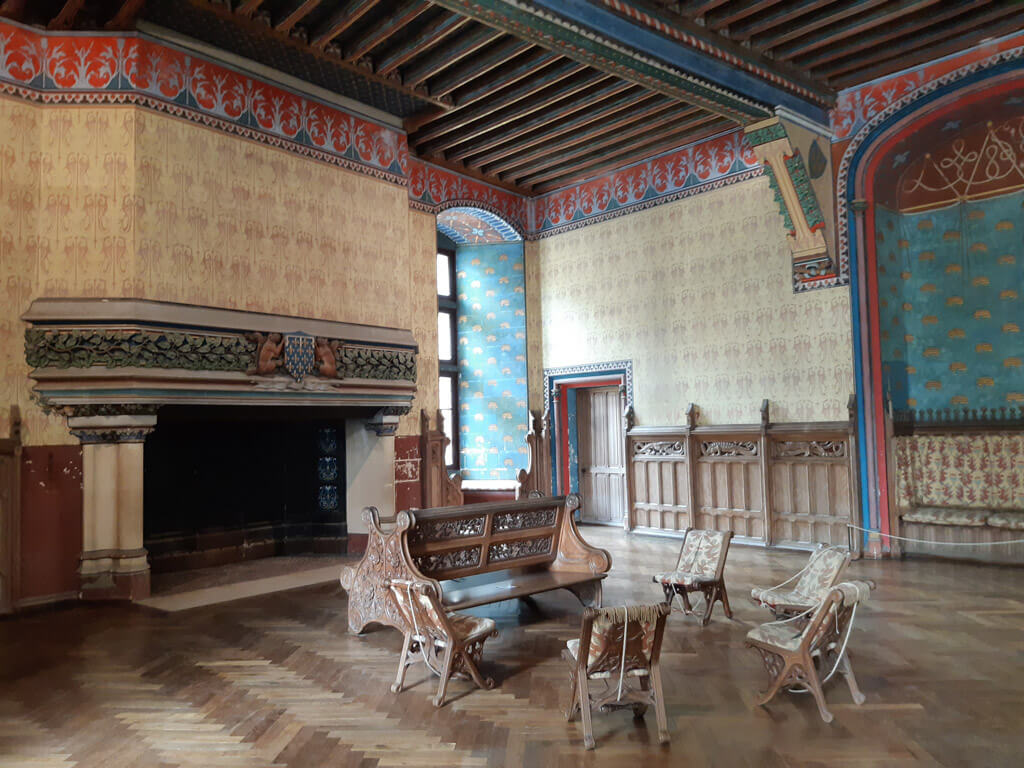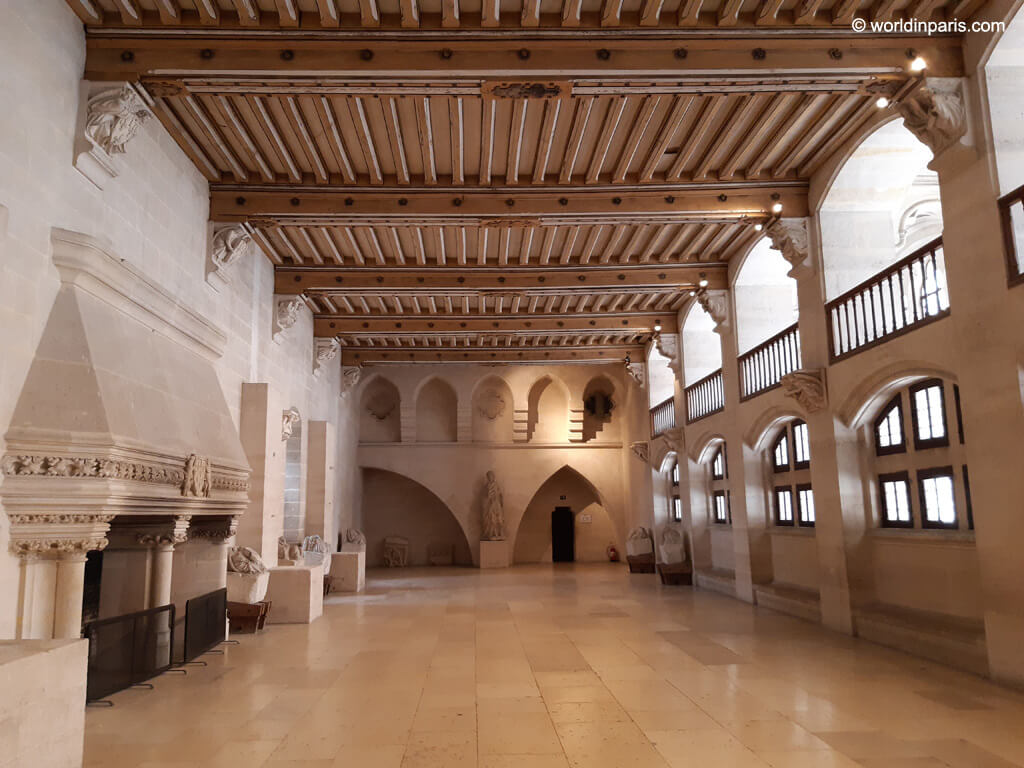Day Trip to Château de Pierrefonds from Paris
Château de Pierrefonds is arguably one of the most beautiful castles near Paris. It is located in the picturesque town of Pierrefonds and it is relatively easy to visit on a day trip from Paris.
How to get to Château de Pierrefonds, where to park, how much it costs to enter and all other useful information can be found in this article.
Château de Pierrefonds makes a beautiful day trip from Paris. Click here for the list of best day trips from Paris

Best Ways to Visit Château de Pierrefonds from Paris

There are two ways to get to Château de Pierrefonds from Paris, make it on your own by car or by train + bus.
By Train + Bus
Trains to Compiègne leave from Gare du Nord hourly. From the train station in Compiègne, there’s a bus to Pierrefonds (#27 or #27-28) 3 times a day at 8.30 am, 11.30 am, and 17.00 pm.
By Car
This is the easiest day to visit Château de Pierrefonds from Paris. The castle is located 85 km northeast of Paris and the drive takes less than one hour.
From Paris, take highway A1, exit #9. Then take the road D200 to Compiègne and then the road D973.
There is a free carpark at rue Sabatier, 10 minute walk from the château.
Château de Pierrefonds Tickets and Opening Hours
To avoid overcrowding, the château has reduced the number of daily visitors. Today, it is strongly recommended to buy tickets online and in advance. Tickets to the château are for a specific date and time slot.
Visitors entitled to free admission also need to get a ticket with a specific date and time slot in advance. The price of this ticket will be 0€.
Click here to buy your tickets to Château de Pierrefonds
The Château de Pierrefonds is open every day from 9.30 am to 6 pm (last access before the closing time). The visit lasts around one hour. The château is closed on 1st January, 1st May, and 25th December.
History of Château de Pierrefonds

Château de Pierrefonds was erected in the late 14th century by Duke Louis of Orléans. The construction of this château was intended for the surveillance of the exchanges between Flanders and Burgundy, two domains that belonged to the family of the Dukes of Burgundy, rivals of Orléans.
Over the next centuries, the château changed hands several times: Dukes of Burgundy, Dukes of Orléans, and French Kings owned Pierrefonds.
During the early days of King Louis XIII’s reign, the castle was the property of François-Annibal d’Estrées. He joined the party of discontent led by Henri II, Prince of Condé, against King Louis XIII. In March 1617 Château de Pierrefonds was besieged and taken by troops sent by Richelieu, the King’s secretary state of war.
King Louis XIII intended to demolish the château to prevent it to become a refuge for his enemies but the job was not completed because of the enormity of the task. The château remained a ruin for more than two centuries.
During the 18th century, the abandoned castle attracted a few rare visitors inspired by the romantic beauty of this medieval ruin. In 1798 Château de Pierrefonds was sold as national property for 8,100 francs. Napoleon I bought it back in 1813 for 2,700 francs.
The current château dates back to the 19th century when Emperor Napoleon III decided to rebuild it and use it as an imperial residence. To do so, he hired the architect Viollet-le-Duc who restored the château in ruins and added a bit of his fantasy.
Today, Château de Pierrefonds works as a national museum and it is listed Historic Museum since 1862.
A Peek Inside Château de Pierrefonds

The Château de Pierrefonds includes most of the characteristics of defensive military architecture from the Middle Ages. It also has many aesthetic licenses, product of Viollet-le-Duc’s imagination.
The château has eight towers adorned with the sculptures of eight worthy knights and kings, all heroes of Antiquity and Middle Ages.
For its reconstruction, Viollet-le-Duc placed a ditch and several external defense devices which have no military effectiveness, but which contribute to the aspect of theatrical setting.
We especially loved the interiors, painted with bright colors and decorated with blazons, fabulous creatures, and many interesting details.
Here’s a peek of our favorite rooms and halls inside Château de Pierrefonds.
Main Courtyard

The courtyard brings together different architectural styles, mainly Medieval and Renaissance. It is dominated by the equestrian statue of Louis of Orléans and some huge salamanders, symbol of the duke, act as gargoyles.


From this courtyard, visitors can access the keep, chapel, and the main rooms and halls.
The Reception Room

In the 19th century, Napoleon III and his wife received their relatives and intimate friends here. This room has amazing Hungarian woodwork sculpted with fantastic animals and painted with bright colors. The friezes are inspired by plant patterns.
The beautiful firework bears the arms of the Dukes of Orléans, held by two squirrels. Just in front of the fireplace, there are some wooden chairs and a seat with a reversible back designed by Viollet-le-Duc.


The following rooms are decorated with similar patterns, colors, and the symbols of the Emperors: bees for Napoleon I and eagles for Napoleon III.
The Worthies Room

This is the most impressive hall, measuring 9,5 m wide and 52 m long, and covered by a vaulted roof illuminated by 22 windows.
Under the Second Empire, this place served as a reception hall as well as a ballroom. Visitors could also admire the Emperor’s collection of armors. This collection was transferred to the Army Museum at Les Invalides after the fall of the Empire.
The portal to access the hall is richly decorated with statues-columns with, in the center, the Emperor Charlemagne surrounded by the princes paladins whilst two angels hold the Imperial blazon. The tribune above was for the orchestra.

On the other side of the hall, the giant fireplace is decorated with the nine worthies, female statues evoking the courtly love. The faces of the nine worthies were inspired by those of the Empress and her ladies-in-waiting.


The Guard Room

This also impressive room is located just below the Reception Room. Today visitors can see some fragments of the former castle found during the excavation works for the reconstruction of Château de Pierrefonds. The fireplace was designed by Viollet-le-Duc.

